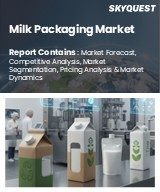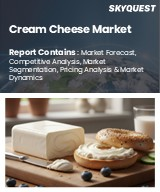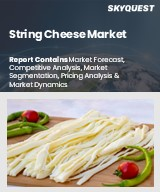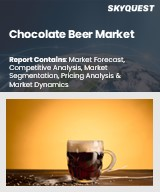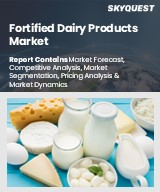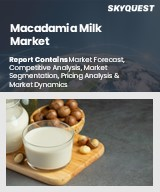
|
시장보고서
상품코드
1660988
세계의 음용 우유 시장 보고서 : 유형별, 포장 재료별, 유통 채널별, 지역별(2025-2033년)Fluid Milk Market Report by Type, Packaging Material, Distribution Channel, and Region 2025-2033 |
||||||
세계의 음용 우유 시장 규모는 2024년 1,884억 달러에 달했습니다. IMARC Group은 2025년부터 2033년까지 성장률(CAGR)은 1.82%로 성장해, 2033년에는 2,227억 달러에 달할 것으로 예측했습니다. 이 시장은 비타민, 미네랄, 프로바이오틱스를 강화한 기능성·강화 유제품에 대한 수요 증가, 급속한 도시화, 식사 제한이나 유당 불내증의 사람에 대응하기 위한 무유당·식물성 대체 우유 시장 개척 등에 의해 꾸준한 성장을 이루고 있습니다.
음용 우유 시장 분석 :
시장 성장과 규모: 시장은 인구 증가, 도시화, 식생활 변화에 견인되어 안정적인 성장을 이루고 있습니다. 고단백, 고칼슘 함유 등 우유의 영양면에서의 이점에 대한 대중의식의 고조가 시장 성장을 뒷받침하고 있습니다.
기술 진보 : 우유 생산 및 가공의 기술 혁신은 효율성과 품질을 향상시켜 보존성을 향상시키고 폐기물을 줄입니다. 착유 로봇이나 사물인터넷(IoT) 대응 시스템 등 낙농의 자동화가 시장 성장을 뒷받침하고 있습니다.
산업용도: 음용 우유는 다재다능한 제품이며, 우유음료, 요구르트, 치즈제조 등 다양한 용도로 널리 사용되고 있습니다. 또한 베이커리 및 과자류의 중요한 원료이기도 합니다.
지리적 동향 : 아시아는 인구가 많고 식생활도 풍부하기 때문에 시장을 선도하고 있습니다. 그러나 북미는 유동식의 품질과 지역차가 중시되어 급성장 시장으로 부상하고 있습니다.
경쟁 구도 : 주요 기업은 소비자의 선호 변화에 대응하기 위해 향료 우유와 강화 우유, 유제품 및 유기농 제품의 도입에 주력하고 있습니다. 또한 연구개발(R&D) 활동에도 투자하여 제품 포트폴리오의 혁신과 다양화를 도모하고 있습니다.
과제와 기회 : 유제품 시장은 날씨와 사료 비용 등의 요인으로 인한 유제품 업계의 가격 변동 등의 과제에 직면하고 있지만, 소비자의 다양한 수요에 부응하기 위해 강화 우유와 풍미 우유 등 제품 혁신의 기회에도 조우하고 있습니다.
향후 전망 건강지향 증가와 급속한 도시화로 음용 우유 시장의 미래는 유망합니다. 낙농과 생산에서 지속가능하고 환경친화적인 실천은 시장 성장을 가속할 것으로 예상됩니다.
음용 우유 시장 경향:
소비자의 건강 의식과 영양 중시
소비자의 건강 의식과 영양에 대한 관심 증가는 시장 성장을 강화하고 있습니다. 사람들의 건강 지향이 높아짐에 따라 우유는 필수 영양소, 특히 단백질, 칼슘, 비타민공급원으로 소비되고 있습니다. 소비자는 우유를 매일 영양 요구에 기여할 수있는 자연적이고 건강한 음료로 인식합니다. 영양가가 높고, 현대의 라이프 스타일에 맞는 편리한 선택지로서, 우유에 대한 수요가 높아지고 있어, 사람들에게 선호되는 선택지가 되고 있습니다. 게다가 비타민, 미네랄, 프로바이오틱스를 강화한 것 등 특정 건강 요건이나 기호에 대응하는 기능성·영양 강화 우유 제품에 대한 수요 증가가 양호한 시장 전망을 가져오고 있습니다.
다양한 유제품 혁신
유제품의 끊임없는 혁신과 다양화는 시장 성장을 뒷받침하고 있습니다. 유제품 제조업체는 소비자의 취향과 식생활동의 변화에 대응하기 위해 항상 독창적인 신제품을 발표하고 있습니다. 초콜릿, 딸기, 바닐라 등 풍미 우유의 소개는 어린이와 성인 사이에서 인기를 끌고 있습니다. 이러한 풍미가있는 옵션은 전통적인 우유 카테고리에 자극을 주고 소비 확대에 기여합니다. 또한, 유당을 사용하지 않는 식물성 대체 우유의 개발은 식사 제한과 유당 불내증을 가진 사람들을 수용합니다. 이 외에도 아몬드 우유, 두유, 오트밀 우유는 유제품이없는 대체품이며 유사한 영양 이점을 제공합니다.
수출 기회와 세계 무역
국제 무역 및 수출 기회는 업계 투자자에게 유리한 성장 기회를 제공합니다. 많은 국가들, 특히 낙농산업이 확립한 국가들은 국제시장 진출을 확대하고 유동성 우유 생산과 소비 증가를 촉진하고 있습니다. 게다가 인구 증가, 식생활 변화, 우유 영양 면에서의 이점에 대한 소비자 의식 증가로 유동우유를 포함한 유제품 수요가 증가하고 있습니다. 또한 자유무역협정과 무역자유화 노력을 통해 국경을 넘어 유제품의 이동을 촉진하고 있습니다. 그 결과 유동유와 그 파생품은 보다 폭넓은 소비자에게 넘어가게 되어 유업 제조업체의 매출과 수익에 영향을 미치고 있습니다.
인구 증가와 도시화
세계의 급속한 도시화에 따른 인구 증가가 시장 성장을 뒷받침하고 있습니다. 고용과 생활수준의 향상을 요구하여 도시로 이주하는 사람이 늘어남에 따라, 그들의 식생활은 종종 변화를 일으킵니다. 도시에 사는 사람들은 일반적으로 슈퍼마켓과 편의점을 통해 유동유를 포함한 팩형 유제품을 쉽게 얻을 수 있습니다. 게다가, 도시 환경에서의 라이프 스타일의 변화는 편리하고 곧바로 마실 수 있는 식품 및 음료 제품에 대한 기호가 높아지게 되어, 유동식이 매력적인 선택지가 되는 경우가 많습니다.
목차
제1장 서문
제2장 조사 범위와 조사 방법
- 조사의 목적
- 이해관계자
- 데이터 소스
- 1차 정보
- 2차 정보
- 시장 추정
- 상향식 접근
- 하향식 접근
- 조사 방법
제3장 주요 요약
제4장 소개
- 개요
- 주요 업계 동향
제5장 세계의 음용 우유 산업
- 시장 개요
- 시장 실적
- 수량 동향
- 금액 동향
- COVID-19의 영향
- 가격 분석
- 주요 가격 지표
- 가격구조
- 가격 동향
- 시장 분석 : 지역별
- 시장 분석 : 유형별
- 시장 분석 : 포장재료별
- 시장 분석 : 유통채널별
- 시장 예측
- SWOT 분석
- 개요
- 강점
- 약점
- 기회
- 위협
- 밸류체인 분석
- 원재료 조달
- 제조업체
- 마케팅과 유통
- 소매업체
- 수출업체
- 최종 사용자
- Porter's Five Forces 분석
- 개요
- 구매자의 협상력
- 공급기업의 협상력
- 경쟁도
- 신규 참가업체의 위협
- 대체품의 위협
- 주요 성공 요인과 위험 요인
제6장 주요 지역의 실적
- 아시아
- 시장 동향
- 시장 예측
- 유럽연합
- 시장 동향
- 시장 예측
- 북미
- 시장 동향
- 시장 예측
- 동부 유럽
- 시장 동향
- 시장 예측
- 라틴아메리카
- 시장 동향
- 시장 예측
- 오세아니아
- 시장 동향
- 시장 예측
- 기타
- 시장 동향
- 시장 예측
제7장 시장 분석 : 유형별
- 전체
- 시장 동향
- 시장 예측
- 지방분 저감
- 시장 동향
- 시장 예측
- 저지방
- 시장 동향
- 시장 예측
- 무지방
- 시장 동향
- 시장 예측
- 유기농
- 시장 동향
- 시장 예측
- 기타
- 시장 동향
- 시장 예측
제8장 시장 분석 : 포장재료별
- 종이
- 시장 동향
- 시장 예측
- 플라스틱
- 시장 동향
- 시장 예측
- 유리
- 시장 동향
- 시장 예측
- 기타
- 시장 동향
- 시장 예측
제9장 시장 분석 : 유통채널별
- 슈퍼마켓/하이퍼마켓
- 시장 동향
- 시장 예측
- 편의점
- 시장 동향
- 시장 예측
- 전문 식료품점
- 시장 동향
- 시장 예측
- 온라인 소매
- 시장 동향
- 시장 예측
- 기타
- 시장 동향
- 시장 예측
제10장 경쟁 구도
- 시장 구조
- 시장 내역 : 주요 기업별
제11장 액체 우유의 제조 공정
- 제품 개요
- 상세한 프로세스 흐름
- 다양한 유형의 단위 조작
- 매스 밸런스와 원재료 요건
제12장 프로젝트의 상세·필요조건·비용
- 토지 요건과 비용
- 건설 요건과 비용
- 공장의 기계
- 기계 사진
- 원재료 요건과 지출
- 원재료와 최종제품의 사진
- 포장 요건과 지출
- 운송 요건과 지출
- 유틸리티 요건과 지출
- 인원 요건과 지출
- 기타 설비투자
제13장 대출과 자금 지원
제14장 프로젝트의 경제성
- 프로젝트의 자본 비용
- 기술 경제적 파라미터
- 공급 체인의 각 단계에서의 제품 가격과 마진
- 과세 및 감가상각
- 수입 예측
- 지출 예측
- 재무 분석
- 이익 분석
제15장 주요 기업 프로파일
- Lactalis International
- Nestle SA
- Fonterra Co-operative Group Limited
- Royal FrieslandCampina NV
- Danone SA
- Dairy Farmers of America Inc.
- Arla Foods amba
- Dean Foods Company
- DMK Deutsches Milchkontor GmbH
- Saputo Inc
- Gujarat Co-operative Milk Marketing Federation Ltd(GCMMF)
- Yili Group
The global fluid milk market size reached USD 188.4 Billion in 2024. Looking forward, IMARC Group expects the market to reach USD 222.7 Billion by 2033, exhibiting a growth rate (CAGR) of 1.82% during 2025-2033. The market is experiencing steady growth driven by the escalating demand for functional and fortified milk products enriched with vitamins, minerals, and probiotics, rapid urbanization, and development of lactose-free and plant-based milk alternatives for catering to individuals with dietary restrictions or lactose intolerance.
Fluid Milk Market Analysis:
Market Growth and Size: The market is witnessing stable growth, driven by population growth, urbanization, and changing dietary habits. The increasing awareness among the masses about nutritional benefits of milk, including its high protein and calcium content, is propelling the market growth.
Technological Advancements: Innovations in milk production and processing are enhancing efficiency and quality, resulting in improved shelf life and reduced waste. Automation in dairy farming, including milking robots and Internet of Things (IoT)-enabled systems, is impelling the market growth.
Industry Applications: Fluid milk is a versatile product, widely used in various applications, including dairy beverages, yogurt, and cheese production. It is also a crucial ingredient in the bakery and confectionery industry.
Geographical Trends: Asia leads the market on account of its large population and dietary habits. However, North America is emerging as a fast-growing market, driven by a strong emphasis on quality and regional variations of the fluid milk.
Competitive Landscape: Key players are focusing on introducing flavored and fortified milk variants, lactose-free options, and organic offerings for catering to changing consumer preferences. They are also investing in research and development (R&D) activities to innovate and diversify their product portfolios.
Challenges and Opportunities: While the market faces challenges like price fluctuations in the dairy industry due to factors like weather and feed costs, it also encounters opportunities in product innovations, such as fortified and flavored milk variants, to meet diverse consumer demands.
Future Outlook: The future of the fluid milk market looks promising, with increasing health consciousness and rapid urbanization. Sustainable and eco-friendly practices in dairy farming and production are likely to gain traction, which is expected to propel the market growth.
Fluid Milk Market Trends:
Consumer health awareness and nutrition focus
Consumer health awareness and a growing focus on nutrition are strengthening the growth of the market. As people are becoming increasingly health-conscious, they are consuming milk, as it is a source of essential nutrients, particularly protein, calcium, and vitamins. Consumers are recognizing milk as a natural and wholesome beverage that can contribute to their daily nutritional needs. The rising demand for milk as a nutritious and convenient option that aligns with modern lifestyles, making it a preferred choice for people. Moreover, the growing demand for functional and fortified milk products, such as those enriched with vitamins, minerals, and probiotics, that caters to specific health requirements and preferences is offering a favorable market outlook.
Diverse dairy product innovation
Continuous innovations and diversification of dairy products are propelling the growth of the market. Dairy producers are constantly introducing new and creative products for cater to changing consumer preferences and dietary trends. The introduction of flavored milk variants, such as chocolate, strawberry, and vanilla, are gaining traction among children and adults. These flavored options add excitement to the traditional milk category and contribute to increased consumption. Additionally, the development of lactose-free and plant-based milk alternatives is catering to individuals with dietary restrictions or lactose intolerance. Besides this, almond, soy, and oat milk offer dairy-free alternatives that provide similar nutritional benefits.
Export opportunities and global trade
International trade and export opportunities are offering lucrative growth opportunities to industry investors. Many countries, particularly those with well-established dairy industries, are expanding their reach to international markets, driving increased production and consumption of fluid milk. In addition, the demand for dairy products, including fluid milk, is rising due to the growing population, changing dietary habits, and increasing consumer awareness about the nutritional benefits of milk. Moreover, free trade agreements and trade liberalization efforts are facilitating the movement of dairy products across borders. As a result, fluid milk and its derivatives can reach a broader range of consumers, influencing sales and revenue for dairy producers.
Population growth and urbanization
The increasing population, along with rapid urbanization around the world, is bolstering the growth of the market. As more people are migrating to urban areas in search of employment and better living standards, their dietary habits often undergo a transformation. Urban dwellers typically have easier access to packaged dairy products, including fluid milk, through supermarkets and convenience stores. Furthermore, changing lifestyles in urban settings often lead to an increasing preferences for convenient and ready-to-consume food and beverage products, making fluid milk an attractive option.
Fluid Milk Industry Segmentation:
Breakup by Type:
- Whole
- Reduced Fat
- Low Fat
- Fat Free
- Organic
- Others
Whole accounts for the majority of the market share
Reduced fat milk, typically with less fat content, is the choice of consumers seeking a compromise between flavor and calorie content. This segment caters to health-conscious individuals who want the taste of milk but with lower fat levels. It is often used as a staple in households for drinking and cereal consumption. Reduced fat milk aligns with dietary guidelines advocating for reduced saturated fat intake, making it a popular option in many markets.
Low fat milk, typically containing 1% fat or less, is a segment chosen by individuals who prioritize health and weight management. It is widely used in diets and by those aiming to reduce calorie intake. Low fat milk is versatile, serving as a base for various dairy products and being a popular choice for those looking to maintain a balance between nutrition and taste.
Fat-free milk, also known as skim milk, contains minimal or no fat content. It is a preferred choice for individuals focused on calorie reduction, heart health, or dietary restrictions. Fat-free milk is often used in cooking, baking, and as a beverage for those who want the benefits of milk without the fat. It plays a crucial role in catering to specific dietary needs, including those with lactose intolerance.
The organic milk segment is witnessing substantial growth due to increasing consumer preferences for natural and sustainably produced products. Organic milk is sourced from cows raised without synthetic hormones or antibiotics and fed organic feed. It appeals to consumers concerned about the environment and animal welfare.
Breakup by Packaging Material:
- Paper
- Plastic
- Glass
- Others
Paper holds the largest share in the industry
Paper packaging materials are widely used due to their affordability, recyclability, and eco-friendliness. These packages offer excellent protection against light and air, preserving the freshness of the milk. They are popular choices among consumers who are environment conscious and prefer sustainable packaging options. They are often used for long shelf-life milk products and contribute to reducing the carbon footprint associated with packaging.
Plastic containers are known for their durability and convenience. They are lightweight and shatterproof, making them a preferred choice for on-the-go consumption. While plastic packaging may not be as environment friendly as paper or glass, they are still recyclable in many regions. Plastic bottles often come in various sizes, catering to different consumer needs, ranging from single-serving bottles to larger family-sized containers.
Glass bottles are preferred by consumers who value the preservation of taste and freshness, as glass is non-reactive and does not impart any odor or taste to the milk. They are often associated with premium or specialty milk products. Glass bottles are fully recyclable and provide an option for consumers who prioritize sustainability and want to reduce plastic usage.
Breakup by Distribution Channel:
- Supermarkets and Hypermarkets
- Convenience Stores
- Specialty Food Stores
- Online Retail
- Others
Supermarkets and hypermarkets represent the leading market segment
Convenience stores play a crucial role in the fluid milk market by offering quick and accessible options for consumers on the go. They provide smaller, single-serving packages of milk, making it convenient for consumers looking for a quick refreshment or snack. While their milk selection may be more limited compared to supermarkets, convenience stores serve an important niche for impulse buyers and those in need of last-minute dairy products.
Specialty food stores, including health food stores and organic markets, cater to consumers with specific dietary preferences or those seeking premium and specialty fluid milk products. These stores often feature organic, lactose-free, or other niche milk options that may not be readily available in conventional retail outlets. They appeal to health-conscious and discerning consumers who prioritize quality and unique offerings.
The online retail segment is witnessing rapid growth in the fluid milk market. Online platforms offer convenience and an extensive range of milk products, including various packaging sizes and specialty options. Consumers can browse, compare, and order milk from the comfort of their homes, making it especially appealing to busy urban dwellers.
Breakup by Region:
- Asia
- European Union
- North America
- Eastern Europe
- Latin America
- Oceania
- Others
Asia leads the market, accounting for the largest fluid milk market share
The market research report has also provided a comprehensive analysis of all the major regional markets, which include Asia, European Union, North America, Eastern Europe, Latin America, Oceania, and Others. According to the report, Asia accounted for the largest market share due to its vast population, increasing urbanization, and changing dietary habits. Countries like China and India are major consumers of milk, both for direct consumption and as ingredients in various food products. In addition, the growing middle class, along with inflating income levels of individuals, are leading to higher dairy consumption in the region.
The European Union (EU) is a well-established market for fluid milk products, known for its high-quality dairy standards. The region values dairy traditions, with a strong preference for fresh and locally sourced milk. While consumption levels are relatively stable, there is a growing demand for organic and specialty milk products, reflecting changing consumer preferences for premium and sustainable options.
North America represents a substantial market for fluid milk, with the United States being a major consumer. The market is influenced by shifts in consumer preferences, with some consumers opting for alternative milk products like almond and soy milk. Nevertheless, dairy milk remains a staple in many households, and there is a continued demand for traditional and specialty fluid milk products.
Eastern Europe is an emerging market for fluid milk, with increasing consumption due to improving living standards and access to a wider range of dairy products. Countries in this region are witnessing a transition from older dairy traditions to more modern consumption patterns, including the adoption of flavored and fortified milk options.
Latin America has a growing presence in the global fluid milk market, driven by population growth and rapid urbanization. Countries like Brazil and Mexico are experiencing rising milk consumption as consumers incorporate dairy products into their diets. The region also presents opportunities for dairy companies to introduce fortified and flavored milk products tailored to local tastes.
Oceania, with countries like Australia and New Zealand, is known for its high-quality dairy products and exports. It plays a significant role in the global fluid milk market, particularly in the export of milk powder and dairy ingredients. The dairy industry in the region is characterized by its focus on sustainability and quality, attracting consumers looking for premium milk products.
Leading Key Players in the Fluid Milk Industry:
Key players in the market are actively engaged in several strategic initiatives to maintain and expand their market presence. They are investing in research and development (R&D) activities to innovate and diversify their product portfolios. This includes the introduction of flavored and fortified milk variants, lactose-free options, and organic offerings to cater to changing consumer preferences. Additionally, sustainability is a growing focus, with many players implementing eco-friendly practices in dairy farming and packaging. Marketing efforts emphasize the nutritional benefits of milk to promote its consumption and counter competition from alternative milk products. Furthermore, they are expanding their distribution networks, both in traditional retail and online channels, to reach a broader consumer base.
The market research report has provided a comprehensive analysis of the competitive landscape. Detailed profiles of all major companies have also been provided. Some of the key players in the market include:
- Lactalis International
- Nestle S.A.
- Fonterra Co-operative Group Limited
- Royal FrieslandCampina N.V.
- Danone S.A.
- Dairy Farmers of America Inc.
- Arla Foods amba
- Dean Foods Company
- DMK Deutsches Milchkontor GmbH
- Saputo Inc
- Gujarat Co-operative Milk Marketing Federation Ltd (GCMMF)
- Yili Group
Key Questions Answered in This Report
- 1.What was the size of the global fluid milk market in 2024?
- 2.What is the expected growth rate of the global fluid milk market during 2025-2033?
- 3.What has been the impact of COVID-19 on the global fluid milk market?
- 4.What are the key factors driving the global fluid milk market?
- 5.What is the breakup of the global fluid milk market based on the type?
- 6.What is the breakup of the global fluid milk market based on the packaging material?
- 7.What is the breakup of the global fluid milk market based on the distribution channel?
- 8.What are the key regions in the global fluid milk market?
- 9.Who are the key players/companies in the global fluid milk market?
Table of Contents
1 Preface
2 Scope and Methodology
- 2.1 Objectives of the Study
- 2.2 Stakeholders
- 2.3 Data Sources
- 2.3.1 Primary Sources
- 2.3.2 Secondary Sources
- 2.4 Market Estimation
- 2.4.1 Bottom-Up Approach
- 2.4.2 Top-Down Approach
- 2.5 Forecasting Methodology
3 Executive Summary
4 Introduction
- 4.1 Overview
- 4.2 Key Industry Trends
5 Global Fluid Milk Industry
- 5.1 Market Overview
- 5.2 Market Performance
- 5.2.1 Volume Trends
- 5.2.2 Value Trends
- 5.3 Impact of COVID-19
- 5.4 Price Analysis
- 5.4.1 Key Price Indicators
- 5.4.2 Price Structure
- 5.4.3 Price Trends
- 5.5 Market Breakup by Region
- 5.6 Market Breakup by Type
- 5.7 Market Breakup by Packaging Material
- 5.8 Market Breakup by Distribution Channel
- 5.9 Market Forecast
- 5.10 SWOT Analysis
- 5.10.1 Overview
- 5.10.2 Strengths
- 5.10.3 Weaknesses
- 5.10.4 Opportunities
- 5.10.5 Threats
- 5.11 Value Chain Analysis
- 5.11.1 Raw Material Procurement
- 5.11.2 Manufacturers
- 5.11.3 Marketing and Distribution
- 5.11.4 Retailers
- 5.11.5 Exporters
- 5.11.6 End-User
- 5.12 Porter's Five Forces Analysis
- 5.12.1 Overview
- 5.12.2 Bargaining Power of Buyers
- 5.12.3 Bargaining Power of Suppliers
- 5.12.4 Degree of Competition
- 5.12.5 Threat of New Entrants
- 5.12.6 Threat of Substitutes
- 5.13 Key Success Factors and Risk Factors
6 Performance of Key Regions
- 6.1 Asia
- 6.1.1 Market Trends
- 6.1.2 Market Forecast
- 6.2 European Union
- 6.2.1 Market Trends
- 6.2.2 Market Forecast
- 6.3 North America
- 6.3.1 Market Trends
- 6.3.2 Market Forecast
- 6.4 Eastern Europe
- 6.4.1 Market Trends
- 6.4.2 Market Forecast
- 6.5 Latin America
- 6.5.1 Market Trends
- 6.5.2 Market Forecast
- 6.6 Oceania
- 6.6.1 Market Trends
- 6.6.2 Market Forecast
- 6.7 Others
- 6.7.1 Market Trends
- 6.7.2 Market Forecast
7 Market Breakup by Type
- 7.1 Whole
- 7.1.1 Market Trends
- 7.1.2 Market Forecast
- 7.2 Reduced Fat
- 7.2.1 Market Trends
- 7.2.2 Market Forecast
- 7.3 Low Fat
- 7.3.1 Market Trends
- 7.3.2 Market Forecast
- 7.4 Fat Free
- 7.4.1 Market Trends
- 7.4.2 Market Forecast
- 7.5 Organic
- 7.5.1 Market Trends
- 7.5.2 Market Forecast
- 7.6 Others
- 7.6.1 Market Trends
- 7.6.2 Market Forecast
8 Market Breakup by Packaging Material
- 8.1 Paper
- 8.1.1 Market Trends
- 8.1.2 Market Forecast
- 8.2 Plastic
- 8.2.1 Market Trends
- 8.2.2 Market Forecast
- 8.3 Glass
- 8.3.1 Market Trends
- 8.3.2 Market Forecast
- 8.4 Others
- 8.4.1 Market Trends
- 8.4.2 Market Forecast
9 Market Breakup by Distribution Channel
- 9.1 Supermarkets and Hypermarkets
- 9.1.1 Market Trends
- 9.1.2 Market Forecast
- 9.2 Convenience Stores
- 9.2.1 Market Trends
- 9.2.2 Market Forecast
- 9.3 Specialty Food Stores
- 9.3.1 Market Trends
- 9.3.2 Market Forecast
- 9.4 Online Retail
- 9.4.1 Market Trends
- 9.4.2 Market Forecast
- 9.5 Others
- 9.5.1 Market Trends
- 9.5.2 Market Forecast
10 Competitive Landscape
- 10.1 Market Structure
- 10.2 Market Breakup by Key Players
11 Fluid Milk Manufacturing Process
- 11.1 Product Overview
- 11.2 Detailed Process Flow
- 11.3 Various Types of Unit Operations Involved
- 11.4 Mass Balance and Raw Material Requirements
12 Project Details, Requirements and Costs Involved
- 12.1 Land Requirements and Expenditures
- 12.2 Construction Requirements and Expenditures
- 12.3 Plant Machinery
- 12.4 Machinery Pictures
- 12.5 Raw Material Requirements and Expenditures
- 12.6 Raw Material and Final Product Pictures
- 12.7 Packaging Requirements and Expenditures
- 12.8 Transportation Requirements and Expenditures
- 12.9 Utility Requirements and Expenditures
- 12.10 Manpower Requirements and Expenditures
- 12.11 Other Capital Investments
13 Loans and Financial Assistance
14 Project Economics
- 14.1 Capital Cost of the Project
- 14.2 Techno-Economic Parameters
- 14.3 Product Pricing and Margins Across Various Levels of the Supply Chain
- 14.4 Taxation and Depreciation
- 14.5 Income Projections
- 14.6 Expenditure Projections
- 14.7 Financial Analysis
- 14.8 Profit Analysis
15 Key Player Profiles
- 15.1 Lactalis International
- 15.2 Nestle S.A.
- 15.3 Fonterra Co-operative Group Limited
- 15.4 Royal FrieslandCampina N.V.
- 15.5 Danone S.A.
- 15.6 Dairy Farmers of America Inc.
- 15.7 Arla Foods amba
- 15.8 Dean Foods Company
- 15.9 DMK Deutsches Milchkontor GmbH
- 15.10 Saputo Inc
- 15.11 Gujarat Co-operative Milk Marketing Federation Ltd (GCMMF)
- 15.12 Yili Group




